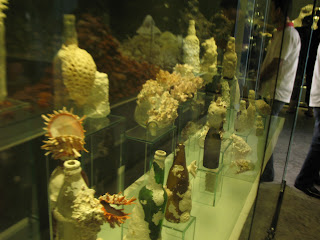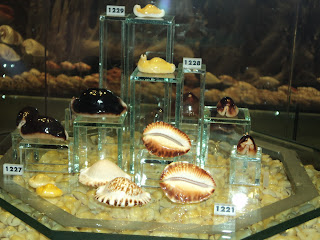"Welcome to Phuket!" exclaimed Jom Patamakanthin, as he let us (my family and me) into his golden-bronze Isuzu 4WD. Fresh from a busy schedule of meetings and office work, Jom has made extra effort to personally pick us up from our hotel to his museum. Earlier on, he has even arranged the hotel's room prior to our arrival in Phuket! Surely, he must be packed full of enthusiasm to welcome us with such kind hospitality! And as I discover later, what brimful of enthusiasm he has!
Born to a father who treasures every piece of shelled-mollusc and a mother who relentlessly encourages him to pursue his interests, Jom is literally given the position to hold the baton as one of Thailand's leading shell expert. Jom's father, Somnuek Patamakanthin, has been the household name in not just shell-collecting circles but also in the fields of conchology and malacology within and beyond the shores of Thailand. This is due to his interest in shell collecting since he was a child, 50 years ago. His helpful and friendly nature has enabled him to exchange shells with like-minded hobbyists as well as donating his specimens to scientists for research purposes. It is such rare opportunity that has allowed him to bridge the often divisive gap between marine scientists and shell collectors. In fact, Somnuek's contribution extends beyond science and hobby.
"You see the logo up on that building?" Jom pointed to a large shopping centre while driving through the central Phuket region, "That's Stellaria solaris, the Sunburst Carrier Shell," he revealed. Jom related that few years ago, his father generously borrowed the designer of the Central Festival Shopping Centre many of his shell books to draw inspiration for the mall's logo. Besides the logo, Somnuek's generosity has also given the designer ideas on the mall's interior decor.
Of course, there's no doubt that Jom has been heavily influenced by his father. Being a self-taught scholar with a peculiar taste for an unorthodox way of learning, Jom has surprised his peers with his high academic results. "People kept asking me," Jom recalled, " 'Hey Jom, how do you study in such a crowded place?' ", referring to his favourite haunt- the shopping malls. "Focus..... and commitment," Jom quipped with a smile.
Perhaps that is the philosophy that is fueling his enthusiasm in shells. Jom has been exposed to the world of shells since childhood but it had never occurred to him that it will play a big part of his life soon. The moment came when Jom was introduced to the shell trade and exchange arena in his early teenage years. "It is the moment that I said to myself 'This is my future!' " Jom remembered. He started to extend his social circle into both the shell-enthusiasts and the scientific community, mirroring his father's move. In the years since then, Jom and Somnuek have their names honoured by having many new species and subspecies named after them, such as Conus patamakanthini (Delsaerdt 1997), Alycaeus somnueki (Panha & Patamakanthin 1999), Haliotis ovina f. patamakanthini (Dekker, Regter & Gras, 2001) and Epitonium patamakanthini (Gittenberger & Gittenberger, 2005).
But arguably the biggest contribution the Patamakanthins have on the molluscan world is the Shell World, a collection of museums that house tens of thousands of species of shelled molluscs, ranging from the downward minuscule to the goliaths of shells. Having spent years exchanging specimens and information between friends, the father and son decided to shift their paradigm to a new level- to bring the world of shelled molluscs to the general public. Utilising their enormous wealth of specimens from their collection, they laboriously studied and prepared thousands of exhibits.
In November 1997, Somnuek founded the first private shell-museum in Thailand (and probably the only one in this part of the world) with his brothers and sisters. Located in the popular Rawai district of Phuket, the Phuket Seashell Museum made waves across the world's mollusc-loving community. It has earned the praise of many as being among the best private and shell museum in the world. Not long after, Jom endeavoured an ambitious plan to extend his family's enterprise by establishing another shell museum in the popular resort island of Sentosa, Singapore. He spent many days designing and outlining the exhibits for his future museum. Alas, his plan collapsed due to difficulties with land issues. Not intending to back down, he started anew back in his country. Along with his shell-collecting friend, Ms. Oraphin Sirirat, Jom established the Bangkok Seashell Museum. By now, the Patamakanthin's labour of love have been recognised by many who had visited and been awed by their treasured collection.
Recently, Jom announced that he will continue to seek new locations fit for more shell museums, which led me to one question everyone's eager to find out: Why build so many shell museums? To that, Jom answered with such down-to-earth honesty and humility, "I'd like to share my knowledge with everyone......and to make and meet new friends along the way."
The entrance to Jom's newest shell museum in the newly opened Jungceylon Shopping Mall, Patong, Phuket. Note the gate's design is inspired by the spider conch, Lambis sp.
The sheer number of species and specimens on display easily outnumber an exhaustive list of superlatives fit for describing it!
The museum display starts with the nolluscs of a bygone era, such as this precious assemblage of Morroccan Nautilus, Cenoceras sp.

The multitude of fossil molluscs in display is an accumulation of specimens from years of exchange with friends from all across the world.
Looks like the shell museum has plenty to satisfy aspiring paleontologists too, with ammonites from various ages.
Jom also has a collection of curious marine-life encrusted objects. "Sometimes, beauty comes in unexpected forms," he said.
Even a collection of all known species and subspecies of present day living nautiluses (the "living fossils") are on display, many of them rarities such as Nautilus macromphalus (Sowerby 1849) and Allonautilus scrobiculatus (Lightfoot 1786).
Even rarer than nautilus, the slit shells (family Pleurotomariidae) is another group of living fossils dating back to more than 500 million years ago. the "wow" factor here is: the sheer number of specimens (and species) on display.
Sitting on the pinnacle of the slit shell section are these two giants-where old meets new. On the left is the world's largest living species, Entemnotrochus rumphii and on the left, a fossilized pleurotomarid.
Jom recalled that his friend found this extremely well-preserved fossil in a French limestone formation many decades ago. He had been waiting for the right time and technology to appear before extracting the shell from the limestone. With cutting edge 21st Century technology, he employed professional jewellery craftsmen to laboriously chip out the deposit and polish the fossil.
Jom also has a keen eye on any variations within a species, bringing seemingly common species such as these Trochus niloticus into new light. he even has a subfossil of the species (on the bottom right corner) unearthed from Phuket itself!
Turbans and Stars (shells, that is) of many species on display.
Arguably, the show-stealer of the day would be this amazing rotor blade-like variant of Angaria sphaerula (Kiener 1839).
The striking colours of so many scallops (family Pectinidae) on display baffles even the most seasoned of shell admirers.
A closeup of the candy coloured scallops of Lion's Paw, Nodipecten fragosus (Conrad 1849).
A mountain of spectacular thorny oysters, Spondylus versicolor (Schreibers 1793).
Another eye-popping spectacle is this metres high pile of Squamose Giant Clams, Tridacna squamosa. In case if you're wondering where on earth did Jom manage to get this much, this pile is retrieved from a collective number of decades-old shell middens (the place where shells are dumped after meals) along many of the Andaman coastal villages with the permission of Thailand's Fisheries Department.
A beautiful collection of porcellanous Turbinella fusus, the much rarer cousin of the Indian Chank, Turbinella pyrum.
Frogs (family Bursidae) and Tritons (family Ranellidae) are among the group of giants on display.
Comb murexes are one of those iconic shells that often graze beach-themed advertisements.
Jom even has a collection of large abalones (family Haliotidae) including the famous Californian Red Abalone, Haliotis rubra.
Bonnet shells (family Cassidae) displaying the multitude of species within its family.
The museum isn't just home to any shells. Many of its exhibits are in fact rare and endemics, euch as these "Glory Cone Shells" which includes Glory of the Seas Cone, Conus gloriamaris (Chemnitz 1777); Glory of Bengal Cone, Conus bengalensis (Okutani 1968); and Glory of India Cone, Conus milneedwardsi (Jousseaume 1894), among others.
Another family of many rare and endemics, the volutes (family Volutidae) are well known among shell enthusiasts.
But perhaps the most popular of all shells is the cowries (family Cypraeidae). Seen here are the rarest specimens of all: the Zoila Cowries, Zoila ketyana (Raybaudi 1978) (centre bottom); Melanistic cowries (the dark tint is a result of living in waters tainted with heavy metals) (left and right) and the "King and Queen of Cowries", as Jom puts it, the rostrate (deformed, curved up) money cowries, Cypraea moneta (centre top).
Clams such as these are unexpectedly gigantic!
There's even a section dedicated to non-marine molluscs, an often overlooked part of the world of shells. Seen here are the unbelievably beautiful Polymita landsnails, Polymita picta (Born 1778). (far from those drab looking snails in your garden!) Underlying the aesthetics, this group of snails is among the best candidate for demonstrating variation's role in the evolution of species.
More candy-looking landsnails- Indonesia's Asperitas and Chloritis (centre right) and Papua's Papuinas (bottom left).
Just like landsnails, freshwater clams like these (mostly of family Unionidae) demonstrate speciation (species formation) with their endless forms of variants.
But perhaps the most surprising of freshwater molluscs would be this seemingly thalassoid (marine like) freshwater snail Tiphobia horei from Lake Tanganyika, East Africa.
If you're interested in seashells, land and freshwater shells, fossils or any molluscs or even natural history itself, do drop by and visit the Patamakanthin's Shell Museums. You will be amazed! Here are the museum details at the time of publishing:
Phuket Seashell Museum 12/2 Moo 2, Viset Road, Rawai, Muang, Phuket 83130 THAILAND. Phone: 076613666 Fax: 076613777 (link: http://www.phuketseashell.com/main.php )
Bangkok Seashell Museum Silom Road (next to Soi Silom 23, opposite Lerdsin Hospital), Bangkok, THAILAND. Phone (Ms. Sirinthip): 08 9681 3814
Shell World Museum Jungceylon Shopping Centre, Patong, Phuket, THAILAND.
(NOTE: My special thanks to Jom for his kind help in bringing us to his museum and spend time chatting and introducing us to his beautiful collection. )




























